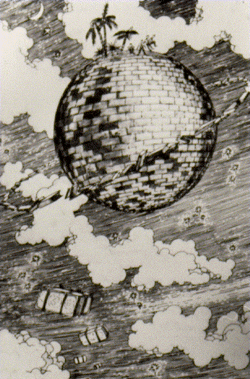The Brick Moon
| "The Brick Moon" | |
|---|---|
 | |
| Author | Edward Everett Hale |
| Country | United States |
| Language | English |
| Genre(s) | Science fiction |
| Published in | The Atlantic Monthly |
| Publication type | magazine |
| Media type | Print (Paperback) |
| Publication date | 1869 |
"The Brick Moon" is a short story by American writer Edward Everett Hale, published serially in The Atlantic Monthly starting in 1869. It is a work of speculative fiction containing the first known depiction of an artificial satellite.
Synopsis
"The Brick Moon" is presented as a journal. It describes the construction and launch into orbit of a sphere, 200 feet in diameter, built of bricks. The device is intended as a navigational aid, but is accidentally launched with people aboard.[1] They survive, and so the story also provides the first known fictional description[1] of a space station.
Publication history
"The Brick Moon" was first released serially in The Atlantic Monthly beginning in 1869, with its final installment appearing in 1870.[2][3] It was collected as the title work in Hale's anthology The Brick Moon and Other Stories in 1899.[4] Hale later wrote a sequel, "Life on the Brick Moon", which was also published in The Atlantic Monthly.[5]
Influence
In 1877, Asaph Hall discovered the two moons of Mars. He wrote to Hale, comparing the smaller Martian moon, Deimos, to the Brick Moon.[2]
References
- 1 2 Mann, Adam (2012-01-25). "Strange Forgotten Space Station Concepts That Never Flew". Wired Magazine. Retrieved 2012-01-24.
- 1 2 "The Brick Moon and Other Stories by Edward Everett Hale". Project Gutenberg.
- ↑ "Contents - The Atlantic monthly. Volume 24, Issue 141". Cornell University Library.
- ↑ Smith, Delbert D. Communication Via Satellite: A Vision in Retrospect. Boston, MA: A. W. Sijthoff, 1976: 16. ISBN 90-286-0296-8
- ↑ Darling, David. The Complete Book of Spaceflight: From Apollo 1 to Zero Gravity. Hoboken, NJ: John Wiley & Sons, 2003: 177. ISBN 0-471-05649-9